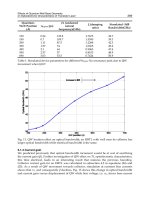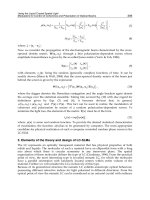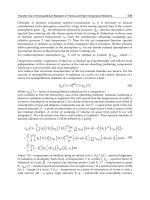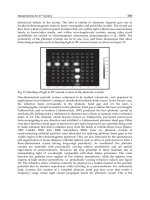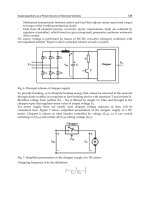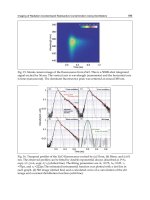Rubber Compounding - Chemistry and Applications Part 8 docx
Bạn đang xem bản rút gọn của tài liệu. Xem và tải ngay bản đầy đủ của tài liệu tại đây (2.08 MB, 80 trang )
7
Silica and Silanes
Walter Meon
Degussa Corporation, Parsippany, New Jersey, U.S.A.
Anke Blume and Hans-Detlef Luginsland
Degussa AG, Cologne, Germany
Stefan Uhrlandt
Degussa Corporation, Piscataway, New Jersey, U.S.A.
I. INTRODUCTION
The invention of synthetic amorphous silica, in the late 1940s, also marked
the birth for the development of new rubber compounds with many more
options and for creating new improved types of rubber. Silica’s progress from
a simple filler used for producing colored rubber compound to an important
physical performance additive for substantially improving rubber com-
pounds, especially in tire applications, took technically about 20 years. But
it did not take long to learn that silica-containing compounds achieve
significantly better tensile strength and tear strength. Therefore, silica
became an important physical reinforcement ingredient in all kinds of rubber
goods in the 1950s and 1960s. Silica manufacturers started to develop and
offer specific silicas for different rubber requirements.
After the first success with commercially available mercaptopropyltri-
methoxysilane in the late 1960s, the polysulfidic silane Si 69
R
*
from Degussa
was introduced in 1972 and set the benchmark for significantly improved
silica-containing compounds. Silanes turned silica into an active chemical
reactant in the rubber compound. An additional 20 years was necessary to
*
Si 69 is a registered trade name of Degussa.
4871-9_Rodgers_Ch07_R2_052404
MD: RODGERS, JOB: 03286, PAGE: 285
Copyright © 2004 by Taylor & Francis
commercially develop the silica and silane success story for the high-volume
tire application that began in Europe.
The use of silica–silane compounds grew slowly. The consumption of
silanes in 1990 was below 3000 metric tons per annum (t/a). The introduc-
tion of the ‘‘green tire’’ from Michelin, with a tread based on a silica from
Rhodia (formerly Rhone Poulenc) and silane from Degussa, was a real
breakthrough in tire innovation. All tire manufacturers had to face this
challenge. But also the silica manufacturers were obliged to offer better
dispersing silicas. Because silica had become an active, high-performance
ingredient for rubber compounds, all major silica manufacturers were devel-
oping so-called highly dispersible (HD) silicas, because only homogeneously
and finely dispersed silica particles can lead to improved reinforcement in the
rubber compound.
Because silane’s importance in rubber has been increasing, new com-
petitors have appeared as a normal consequence of a product’s life cycle in the
market. Competition requires professional research and development to
respond to new requirements and set new trends, to investigate and discover
the complex chemistry that is involved with silanes in silica- and carbon
black–filled rubber compounds. Therefore, this chapter emphasizes the chem-
istry in rubber compounding based on Degussa’s long dedication and expe-
rience in silica and silane research and development conducted by Dr. Stefan
Uhrlandt (Section II) and Dr. Hans-Detlef Luginsland (Sections III and IV).
The whole broad field of rubber applications using silica and silane as
high-performance reactants in rubber compounds is delineated finally in
an extended Section V by Dr. Anke Blume and Dr. Hans-Detlef Luginsland,
supported by experts from the Degussa Applied Technology Centers in
Kalscheuren and Hanau, Germany. Valued editorial reviewing work was
contributed by colleagues from our Technical Center in Akron, Ohio, in
conjunction with John Byers’ support.
II. SILICAS
A. General Considerations and Basic Information
A glance at the occurrence of the homologous chemical elements silicon and
carbon in a variety of locations (Table 1) reveals that although life is based on
carbon, the accessible outer layer of the earth’s lithosphere is primarily of a
siliceous nature (1,2). Silicon as a carrier of ‘‘inorganic life’’ occurs in nature
almost exclusively in the form of crystalline solids in approximately 800
different siliceous minerals. Even in the evolutionary history of humans there
are numerous indications of the omnipresence of silicates in our natural
habitat. Siliceous minerals were utilized either by processing natural silicate
4871-9_Rodgers_Ch07_R2_052404
MD: RODGERS, JOB: 03286, PAGE: 286
Copyright © 2004 by Taylor & Francis
deposits (e.g., clay, kaoline, chalk, or talc) or by means of chemical conversion
(silica, silicones, ceramics). The properties of pure elemental silicon are now of
pivotal importance in the manufacture of integrated switching circuits and
therefore also form the basis for the age of electronics.
Degussa began dealing with siliceous chemicals because of the com-
pany’s involvement in the use of carbon black. In addition to their classic
application as black pigment, carbon blacks were increasingly used as active
fillers in the rubber industry, in particular in the manufacture of automobile
tires. Because the starting material for carbon black at the time—natural
gas—was not available in sufficient quantities in Germany, a substitute was
sought that could be prepared from indigenous starting materials. The
concept of ‘‘white carbon black’’ was born, and research into the manufacture
of siliceous fillers commenced. The idea to apply the manufacturing method
for carbon black to volatile silicon compounds (pyrogenic silica, AerosilR)
also originates from that time. To cite the then Degussa chemist Harry
Kloepfer (3).
Because the significance of a white active filler for the rubber industry
is very evident, I performed several experiments on the manufacture of
a ‘‘white carbon black’’ parallel to the first active carbon black ex-
periments. Even during the initial experiments, I endeavored to imitate
the manufacturing conditions for gas black. The important aspect in
the manufacture of gas black seemed to me to be the direct separation
of ultra-fine carbon particles from the gas phase, i.e., the production
of aerosols.
As described above, fine silicas can be produced by a pyrogenic reaction
or by precipitation. Silicates are manufactured by a precipitation process. It is
an interesting task to precipitate silicas and silicates from aqueous media. The
methods are so variable that various products customized for the respective
applications are attainable. Manufacturers and users of fine silicas and
silicates require analytical characteristic values in order to compare products
(4). Owing to the great differences in chemical composition of silicas, silicates,
and other natural substances such as chalk or siliceous minerals, the charac-
Table 1 Occurrence of the Elements Silicon and Carbon
Location
Occurrence
of silicon
Occurrence
of carbon
Most common
elements
Outer space 0.003% 0.005% H + He 99%
Earth’s crust 27.7% 0.1% O 51%
Human organism 0.01% 9.5% H + O 89%
Source: Ref. 2.
4871-9_Rodgers_Ch07_R2_052404
MD: RODGERS, JOB: 03286, PAGE: 287
Copyright © 2004 by Taylor & Francis
terization usually commences with chemical analysis, which provides impor-
tant information on the product composition, the main constituents, and, of
particular importance, the secondary constituents. One significant constitu-
ent of precipitated silicas and silicates is water, which occurs in various
quantities either chemically bonded or adsorbed. The specific surface area,
mean particle size, particle size distribution, pH, and absorption of certain oils
all play significant roles in the final products. These somewhat ‘‘classic’’
methods of analysis and a number of new methods for characterizing silicas
and silicates will be dealt with in greater detail in Section II.C.
The versatility of fine silicas and silicates is attributable to a variety of
fundamental properties. In chemical terms, they are largely inactive and
exhibit high thermostability; they influence the viscosity of liquids and act
as antisedimentation agents; they are capable of producing matting effects
and of preventing adhesion between foils and the caking of powders. Because
of their high absorbing power, they also serve as carriers for feed and
pesticides. Targeted organic modification of the silica surface converts
‘‘water-friendly,’’ or hydrophilic, silicas into ‘‘water-repelling,’’ or hydro-
phobic, products. The hydrophobic properties have proven to be very useful
for certain applications, e.g., in silicone rubber or for defoaming liquids. The
oldest application of ‘‘ white’’ silicas and silicates, their use in shoe soles and
technical rubber articles, and the use of silicas in modern automobile tires
will be discussed later.
B. Essentials of Rubber Silicas
The oldest use for fine silicas and silicates is in shoe soles. The high demands
with regard to wear can be met with ease by such reinforced vulcanized
materials. The great advantages of light-colored reinforcements vis-a
`
-vis
carbon black is the possibility of satisfying practical, not to mention
fashion-related, requirements, whether they be that shoe soles be nonmark-
ing, transparent, or a particular color, or whether it be necessary to stamp
cable sheaths with colored lettering.
If the fineness and therefore the high specific surface of a substance is
considered to be a main contributing factor to the reinforcing effect in rubber,
then fine silicas and silicates must act similarly to rubber black. This is indeed
the case, but clear distinctions must be made (5). In simple terms, the cross-
linking of rubber during vulcanization proceed in a different manner in the
presence of carbon black than in the presence of silica or silicates. The reasons
for this are adsorption of cure ingredients and the immiscibility of hydrophilic
silica with the hydrophobic rubber. Consequently, silicas are used mostly in
conjunction with bifunctional organosilanes, such as Si 69R. Organosilanes
undergo chemical bonding to the silica surface, thereby providing the
4871-9_Rodgers_Ch07_R2_052404
MD: RODGERS, JOB: 03286, PAGE: 288
Copyright © 2004 by Taylor & Francis
potential for cross-linking to the rubber. The behavior of silica and organo-
silanes will be described in detail in Section III.
C. Characterization of Silicas (Analytical Properties)
Despite the fact that synthetic silicas have been known for a long time, the
question as to how they are best assigned characterization values has yet to be
resolved. In a particular application, the behavior of products frequently
differs from that expected on the basis of the characterization values. There is,
however, still hope that the accurate characterization of a silica will allow
conclusion to be drawn with respect to its mechanism of formation and its
behavior in its intended application. Characterizing a silica means describing
its (surface) structure, i.e., its morphology, as accurately as possible. This
include the ratio between the ‘‘ inner ’’ and ‘‘ outer ’’ surfaces, the size and
shape of pores, the absorption capacity, the surface roughness, the primary
particle size, the formation of aggregates from these primary particles with
the development of siloxane bonds, and the combination of aggregates to
form agglomerates held together by van der Waals forces. Other methods
attempt to characterize the surface chemistry; i.e., they describe the number of
silanol groups and their arrangement, surroundings, and reactivity, and the
chemical composition and degradation behavior of the silica surface. Fur-
thermore, there are a number of methods that can collectively be termed bulk
chemical analysis.
This review attempts to summarize physical and chemical analytical
methods for characterizing silica (6–8) but does not lay claim to completeness.
The more ‘‘ traditional ’’ characterization methods that have been in use for
quite some time are only upon briefly because they are dealt with in the
relevant literature. The main emphasis here is on the new methods—those that
have been specially developed or adapted for the purpose of silica analysis.
Moreover, some analytical methods are more of scientific interest and are
therefore not described in detail either. An extensive bibliography provides
interested parties with the opportunity to pursue the methods in detail.
1. Methods for Characterizing the Morphology of Silica
Specific Surface. The specific surface of a silica is generally determined
by using the Brunauer–Emmett–Teller (BET) adsorption method (9) or a
modification thereof (10,11). For measurement, the sample is cooled to the
temperature of liquid nitrogen. At low temperatures, nitrogen is adsorbed on
the silica surface. The quantity of adsorbed gas is a measure of the size of the
surface. When performed under defined conditions, the BET method yields
perfectly reproducible results. The BET method always provides the sum of
4871-9_Rodgers_Ch07_R2_052404
MD: RODGERS, JOB: 03286, PAGE: 289
Copyright © 2004 by Taylor & Francis
the so-called outer geometrical surface and the inner surface, i.e., the surface
within the porous silica structure. If the value obtained for the surface using
the BET method is compared to that from electron microscopic images, which
indicate only the outer surface, then it is at least possible to estimate the ratio
of outer and inner surfaces. Evaluation of other sections of the BET isotherms
provides additional information. The so-called C value calculated from the
BET isotherms gives a qualitative indication of the magnitude of the
interaction between the surface of the silica and the adsorbed material and
hence of the chemical reactivity of the surface (12). If it is ensured not only
that the surface of a sample is covered with nitrogen but also that the pores are
filled, then the distribution of mesopores (pores between 2 and 30 nm in size)
can also be determined using the Barrett-Joyner-Halendar method (BJH)
method (13).
CTAB Surface Area. One method that is known from the area of
carbon black technology and is also used in the case of silica is based on the
adsorption of surface-active molecules from aqueous solutions. The adsorbed
molecule is cetyltrimethylammonium bromide (CTAB) (14). The preferred
adsorption site for these large CTAB molecules is the outer, geometrical
surface, which correlates quite well with the surface area accessible to the
rubber (15,16). Comparison with the BET surface, which is the sum of the
outer and inner surfaces of a filler, provides an indication, with a certain
margin of error, of the ratio between the inner surface and the total surface.
The CTAB surface often coincides very closely with the surface transmission
determined from electron microscopic (TEM) images.
Sears Determination of the Specific Surface. The Sears number is a
measure of the number of silanol groups on the surface and therefore a
measure of the specific surface of a silica (17,18). The Sears number is equiv-
alent to the quantity of 0.1 N NaOH required to titrate a suspension of silica
from pH 6 to pH 9. The acidic silanol groups on the silica surface react with
NaOH. The Sears number gives an indication of the number of reactive
centers on the surface of a silica.
Pore Volume and Pore Distribution. The term ‘‘ pore volume’’ and a
specific evaluation method have not been described explicitly (19,20). The
pore volume of synthetic silica can be understood as 1) the surface roughness,
2) the micro- or submicropore volume within the particles or aggregates, or 3)
the void volume. The most common method of determining the pore volume
in a silica is mercury porosimetry (21,22). The measured quantity in mercury
porosimetry is the pressure, p, required to force the mercury into the pores of a
sample. The necessary pressure is inversely proportional to the pore diameter.
If the volume of mercury at this pressure is known, then the pore volume can
4871-9_Rodgers_Ch07_R2_052404
MD: RODGERS, JOB: 03286, PAGE: 290
Copyright © 2004 by Taylor & Francis
be calculated. Comparison of the measured curves of different silicas reveals
distinct differences in intrusion and is indicative of very different structures of
the measured products.
E
STIMATION OF INTRA-AGGREGATE AND INTERAGGREGATE STRUC-
TURE
(23). The sharp step at the end of the intrusion curve V = f(R) (Fig. 1a)
corresponds to the intrusion of mercury inside the pores originating from the
open shape ofsilica aggregates. The intrusion volume in this range of pore sizes
is characteristic of the intra-aggregate structure of silica aggregates. This
intra-aggregate structure can be described quantitatively by use of the struc-
ture index (IS), which is the mercury intrusion volume measured between R
min
Figure 1 (a) Intrusion curve and (b) differential curve determination of R
min
and
R
max
and the calculation of the structure index 15.
4871-9_Rodgers_Ch07_R2_052404
MD: RODGERS, JOB: 03286, PAGE: 291
Copyright © 2004 by Taylor & Francis
and R
max
, pore radius values corresponding respectively to the beginning and
the end of the step.
R
min
and R
max
can be easily determined by considering the derivative
curve dV/dR = f(R) (Fig. 1b). R
max
is chosen to match the following condition
on the slope:
d
dR
dV
dR
R
max
V 0:004
dV
dR
max
R
min
is chosen to match the condition
dV
dR
R
min
¼
dV
dR
R
max
The structure index IS depends only on the size and shape of individual
aggregates.
The global structure of a silica, including both intra-aggregate and inter-
aggregate pore volumes, can be estimated using a second structure index
called IS2, defined as the total intrusion volume corresponding to pore radius
values smaller than 4000 nm. IS2 depends on both aggregate shape and
aggregate organization resulting from the drying process.
DBP Number. The assessment of the liquid-absorbing capacity of
synthetic silicas and silicates may involve the absorption of dibutylphthalate
(DBP) (24–26). This largely automated measurement technique provides an
indication of the total volume of liquid that can be absorbed by a silica
sample. The magnitude of the DBP number (24M4-DBP) gives an initial
indication of the interaggregate structure and the processing and dispersion
properties of a silica. Owing to the toxicity of DBP oil, attempts are being
made to replace it with paraffin oil (27). Considering the polarity of the
silica, polar substances such as triethanolamine (TEA) can also be used to
determine the interaggregate structure (24M4-TEA), analogous to the DBP
measurement.
Void Volume. The void volume (28), i.e., the silica structure as a
function of the pressure, is considerably more reliable than the DBP
number. In the void volume method, the sample is subjected to a defined
coarse crushing and then a specified quantity of the sample is transferred to a
cylindrical glass chamber with a volume scale. The chamber is sealed by means
of a moving piston. For the measurement, a constant pressure is applied to the
piston until the volume of the sample in the chamber remains constant. Then
the measured value is read off. Subsequently, the pressure exerted on the
sample is increased again. Figure 2 shows the decrease in structure (or the void
volume) as the pressure increases. This involves comparison of a new silica,
4871-9_Rodgers_Ch07_R2_052404
MD: RODGERS, JOB: 03286, PAGE: 292
Copyright © 2004 by Taylor & Francis
prepared using a modified manufacturing method, with the reference silicas
Zeosil
R
*
1165 MP, Ultrasil
R
7000 GR, and the conventional silica Ultrasil
R
VN 3 GR with the same CTAB surface area. It is obvious that the new
products have a significantly higher void volume even at the start of the
measurement. As the pressure is increased the structure decreases yet always
remains well above the level of the respective reference. In other words, the
higher structure remains intact even when subjected to great stress, e.g., during
mixing in a Banbury mixer. The more stable structure can be penetrated more
easily by polymers and is indicative of the more advantageous mixing and
processing behavior of the silica.
WK Coefficient. To determine the particle distribution and dispers-
ibility (ease of incorporation) of a silica in a polymer matrix, a new method
was developed (29) based on the principle of laser diffraction. The method
uses defined ultrasonic treatment of silica and subsequently measures the size
distribution of particles between 40 nm and 500 Am in diameter. The latest
generation silicas [highly dispersible (HD) silica] exhibit a bimodal distribu-
Figure 2 Decrease in structure of silica as pressure increases.
*
Zeosil (Rhodia SA) and Ultrasil (Degussa) are registered trade names.
4871-9_Rodgers_Ch07_R2_052404
MD: RODGERS, JOB: 03286, PAGE: 293
Copyright © 2004 by Taylor & Francis
tion. The main peak at approximately 10 Am depicts the original agglomerate
structure of the silica. During ultrasonic treatment the silica structure is
destroyed; deagglomeration takes place, and silica aggregates are formed. The
peak corresponding to the silica aggregates lies at approximately 0.4 Am. The
energy input via ultrasound simulates the energy input in mixers typically
used in the rubber industry. The silica with the highest fraction of deagglom-
erated particles has the best dispersibility. By comparing the peak height of
the original agglomerate to that of the degraded agglomerates, the WK
coefficient, which is a measure of the dispersibility of a silica, can be
determined. There is a close correlation between these results and those of
other methods. To a certain extent tire abrasion resistance correlates with the
silica dispersion. This has been substantiated by comparing the results of
dispersion measurements of various silicas of the same surface area with the
results of tire tests on the road (5).
Microscopic Methods. The only method allowing direct insight into
the dimensions of interest in the case of silicas is electron microscopy, which
provides information on the size of primary particles and aggregates or
agglomerates and, with certain limitations, on the particle size distribution
of an examined sample. ‘‘Electron microscopic surfaces’’ can be calculated
from the various particle size distributions, and these can be compared with
those from BET measurements or other investigations.
T
RANSMISSION ELECTRON MICROSCOPY (TEM). Transmission elec-
tron microscopy (TEM) (30) works in much the same manner as light
microscopy: Electrons are passed through a thin object and, following their
interaction with the prepared sample, are used to produce an image. However,
the resolution exceeds that of a light microscope by a factor of 1000; for TEM,
resolution is 0.2–0.3 nm (for a light microscope it is
f
200 nm). TEM images
with high resolution provide valuable information on the composition or
structure of different silica samples. With a suitable imaging technique, even
the crystalline short-range order of silicas and silicates can be detected. The
structure of the silicas can also be recognized, as can the manner in which the
primary particles unite with one another.
S
CANNING ELECTRON MICROSCOPY. The scanning electron micro-
scope (31) is not actually a microscope, in the sense that it uses electromag-
netic lenses in order to magnify images, similar to the case with light optics
(this comparison also applies to the transmission electron microscope). It
merits the name ‘‘electron microscope’’ only because it produces a strongly
magnified image with the help of electrons. As is also the case with TEM,
scanning electron microscopy (SEM) initially produces beams of electrons
from an electron source. The extremely sharply focused beam of electrons
produces very good resolution and depth of focus. It is this great depth of
focus in particular that makes SEM superior to TEM for certain applications.
4871-9_Rodgers_Ch07_R2_052404
MD: RODGERS, JOB: 03286, PAGE: 294
Copyright © 2004 by Taylor & Francis
2. Characterization of Surface Chemistry
Chemical Reactions of Silanol Groups. In the literature, a variety of
methods are described that are suitable for determining silanol groups and
their chemical reactivity on the surfaces of silicas (32–34). All of these
methods are based on applying the experience gathered in small molecule
and low molecular weight chemistry to surface chemistry. However, the fact
that this analogy is flawed is demonstrated by the following simple
consideration. On the surfaces of solids, particularly in the interior of
micropores, spatial inhibition, other equilibrium conditions, and other
reaction possibilities may prevail. Chemical reactions are nonetheless an
important tool for characterizing solid surfaces. The reactions generally
yield easily reproducible characteristic values allowing different products to
be compared. A small selection of the reactions described in the literature will
be dealt with briefly here.
In the determination of silanol groups with lithiumaluminumhydride
(LiAlH
4
), a silica sample is first degassed in a vacuum and then allowed to
react with LiAlH
4
at room temperature, and the resultant hydrogen is
determined volumetrically (35,36). A further method is the reaction of a
sample with an alkyllithium or alkylmagnesium reagent (37) followed by
volumetric determination of the resulting alkane. Further reactions may be
performed with alcohols (38), chlorosilanes (39,40), hexamethylendisilazane;
BCl
3
, AlCl
3
(41), or boroethane (42–44).
NMR Spectroscopy. With
29
Si NMR (19,45–48) examinations of
solids, it is possible to detect different surroundings of the silicon atom on
the basis of the oxygen atoms and hydroxy groups in the silica sample
Scheme 1 Surroundings of Si in silica: geminal, isolated, vicinal, siloxane bridges.
4871-9_Rodgers_Ch07_R2_052404
MD: RODGERS, JOB: 03286, PAGE: 295
Copyright © 2004 by Taylor & Francis
(Scheme 1). The ratios of the detected signal intensities correspond to the
proportions of the various Si surroundings in the sample. With the solid
NMR method, it is possible to distinguish between three main groups around
the silicon atom in silica:
1. Siloxane bridges (bulk) (with a chemical shift of approximately
À110 ppm)
2. Isolated, terminal SiOH (with a chemical shift of approximately
À100 ppm)
3. geminal-SiOH (with a chemical shift of approximately À90 ppm).
The relative content of isolated or geminal silanol groups and siloxane bridges
is quantifiable, and the different silanol groups are assigned different reac-
tivities. For example, with respect to organosilanes as coupling agents (49),
geminal groups are considered to be the most reactive.
Infrared Spectroscopy. Infrared (IR) spectroscopy is another
important method of differentiating between various silanol groups (barring
geminal groups) (50). An overview of the detectable groups is given in Table 2.
Variations of the IR technique contribute the further refinement or
elucidation of the chemical structure on the surface of silica samples. In the
near-infrared (NIR), for instance, the SiOH groups can be quantified by
means of a combined oscillation band. With diffuse reflectance infrared
Fourier transform spectroscopy (DRIFT), an insight can be obtained as to
how the SiOH groups change as the degree of chemical modification
increases. Details on the implementation of other spectroscopic methods
can be found in the literature (S. Uhrlandt, Internal Report NACF 21950226,
Degussa AG, 1995) (51–56). These include X-ray photoelectron spectroscopy
(XPS) (P. Albers, Internal Communication, Degussa AG, 2001), incoherent
neutron scattering (INS), and inverse gas chromatography (IGC) (57,58). The
Table 2 Silanol Groups Detectable by IR Spectroscopy
Si Si
SiUUOH SiUUOH
:::
OH SiUUOH
:::
OH
2
:::
OH
Isolated Vicinal Water bridge
Position of IR band (cm
À1
) 3745 3640 3420
Silica powder, measurement in transmission
x
E (e.g., 3745 cm
À1
/1870 cm
À1
)
SiUUO combination band
relative amount of different silanol groups
Source: M. Janik, Internal Report 05701, Degussa AG, 2001.
4871-9_Rodgers_Ch07_R2_052404
MD: RODGERS, JOB: 03286, PAGE: 296
Copyright © 2004 by Taylor & Francis
use of some of these methods for silica analysis is still in the incipient stage and
thus will not be dealt with here in detail.
Thermoanalytical Methods. Thermal analysis (59) is the term given to
a group of methods that measure a physical property of a substance (and/or
its reaction products) as a function of temperature or time while subjecting
the substance to a controlled temperature program. With differential ther-
mal analysis (DTA) it is possible to monitor the changes in enthalpy of a
sample during the course of a temperature program. The precondition here
is that the corresponding processes (e.g., chemical reactions, phase changes)
are sufficiently short to allow a thermal effect to be observed. DTA is often
combined with thermogravimetry (TG), which records the weight loss of the
sample as a function of the temperature. From the mass loss, information
can be obtained on resulting products and on the possible course of degrada-
tion reactions (60). In the case of silica, rational information can be obtained
only by means of a combined DTA–TG measurement, because the thermal
effects observed in DTA are generally negligible on their own (61). Although it
is difficult to draw conclusions regarding the structure of a silica surface from
the combination of DTA and TG alone, the results obtained can nonetheless
be compared to those from other investigations. From DTA-TG measure-
ments it is possible to calculate surfaces, which can be compared with BET
surfaces, for example. An indication is obtained as to the ratio between the
‘‘outer’’ and ‘‘inner’’ surfaces, and it is also possible to distinguish between
different silanol groups, as is also the case with IR and NMR.
Atomic Force Microscopy. Since the beginning of the 1990s, atomic
force microscopy (AFM) (62–65) has been used to characterize surfaces of
amorphous and crystalline, synthetic and biological products including liquid
crystals and films. AFM combines several analytical methods in one
instrument:
1. Images of the topography of surfaces
2. Measurements of lateral forces of adhesion properties
3. Measurements of modulation forces of the material’s ‘‘hardness’’
4. Measurements of force–distance curves to characterize the ‘‘hard-
ness’’ and ‘‘adhesion’’
Atomic force microscopy can be used to characterize the microstructure
of carbon black and silica surfaces. AFM images allow the analysis of filler
dispersion in the rubber matrix. Depending on the resolution of the images,
filler aggregates and agglomerates in the polymer matrix can be identified.
Small-Angle Scattering. The method of small-angle scattering (SAS)
is a well-known tool to characterize the structure of fine particles and has been
used to investigate fillers for about 60 years (66,67). Because precipitated
4871-9_Rodgers_Ch07_R2_052404
MD: RODGERS, JOB: 03286, PAGE: 297
Copyright © 2004 by Taylor & Francis
silicas behave in most cases as fractal scatterers, the scattering of these
materials can be described with fractal structural concepts (68,69). In a
typical scattering experiment it is possible to estimate primary particle size
and distribution, mass fractal dimension, and aggregate size; all these
parameters depend on the type of silica investigated. For precipitated silica
samples, typical mass fractal dimensions of d
m
= 1.9 F 0.2 can be found (70).
A huge advantage of the small-angle scattering method is the examination of
silica structure when the material is dispersed in various media, for example,
in rubber (71).
3. Chemical Bulk Analyses
X-Ray Diffraction. Synthetic silicas and silicates are amorphous
solids. That is, unlike crystalline solids, they do not possess an infinite
three-dimensional long-range order. Consequently, use of the classic X-ray
diffraction method is not possible. Silicas, however, like glass, do have areas
of short-range order that can be determined by appropriate evaluation of
the diffuse X-ray diffraction bands. Silicas from a variety of manufactur-
ing processes differ from one another in terms of their X-ray diffraction
bands. When the sample is tempered, changes in the short-range order can
be detected at temperatures as low as 200jC using X-ray diffraction (19).
Nevertheless, due to the noncrystallinity in long-range precipitated silicas
are classified as nontoxic and can be handled in production without special
safety precautions.
Loss on Drying and on Ignition. Loss on drying (72) and loss on ignition
(73) are significant characteristic parameters that can be used to character-
ize the differences between synthetic silicas. Silicas prepared by means of
precipitation exhibit a loss on ignition of more than 3% (typical values are
in the region of 5%), provided they have not received special aftertreat-
ment. In the case of pyrogenic silicas, the loss on ignition is less than 3%.
Electrokinetic Measurements. Several electrokinetic methods lend
themselves to the determination of the surface activity of silicas. The
majority are based on measurement of the zeta (electrokinetic) potential.
These include electrophoresis, flow potential, and electroacoustic
measurements such as measurement of the ultrasound vibration potential
(UVP) or electrokinetic sonic amplitude (ESA). In 1991, a working group
headed by Grundke (74) established the following correlation for silicas partly
modified with organosilanes: The lower the SiOH concentration on the silica
surface, the lower the hydrophilic nature of the silica, the lower the surface
activity, and the higher the zeta potential in potassium chloride solution. This
observation is accompanied by an upward shift in the isoelectric point (point
of zero charge). Because the isoelectric point is a measure of the acidity of a
4871-9_Rodgers_Ch07_R2_052404
MD: RODGERS, JOB: 03286, PAGE: 298
Copyright © 2004 by Taylor & Francis
surface, this signifies that the modified surface is of lower acidity than the
unmodified surface, because some of the SiOH groups have reacted with the
organosilanes.
D. Process and Technology
1. Production Process
The various steps of manufacturing silica are displayed schematically in
Scheme 2. In the first step (precipitation), the raw materials consisting of
water glass (sodium silicate solution) and a mineral acid (normally sulfuric
acid is used) are dosed into a stirred vessel containing water. In many cases,
once a defined pH value has been set, the components are fed continuously to
the reactor, this process taking place simultaneously over a certain time
interval. Another possibility is to first supply a particular quantity of water
glass and initially dose just the sulfuric acid. Normally, this is followed by a
second stage in which water glass and sulfuric acid are added simultaneously
under defined reaction conditions.
2. Influence of Process Parameters on Product Properties
During the reaction time, primary particles are first formed in the reactor;
later these particles react with each other, accompanied by dehydration, to
form aggregates. Within the aggregates, the primary particles are linked
together via siloxane bonds. During this process, the aggregates are deposited
to form larger units, or agglomerates. In these agglomerates the aggregates
are held together by hydrogen bonding or van der Waals interactions that are
considerably weaker than siloxane bonds. A state of equilibrium, which is
dependent on the process conditions and can be easily influenced, is reached
between the aggregates and agglomerates (Scheme 3). After that, the obtained
suspension is filtered and the filter cake washed. It can then be resuspended
and spray-dried or fed directly to a short-term drying process. Depending on
the drying technology, the product can be optionally first milled and then
granulated or granulated directly to convert it into a low-dust form.
Scheme 2 Schematic representation of the silica manufacturing process.
4871-9_Rodgers_Ch07_R2_052404
MD: RODGERS, JOB: 03286, PAGE: 299
Copyright © 2004 by Taylor & Francis
3. Dispersibility and Surface Activity
An easy incorporation of the silica into the rubber mixture and its good dis-
persion are crucial because they have a considerable effect on the processing
costs and on the rubber product’s performance. By selecting appropriate
process parameters, it is possible to influence the surface properties and
therefore the reactivity of the silicas toward the organosilane. The silanol
groups on the silica surface should be present in a sufficient amount and be
accessible for reaction with organosilanes to ensure a quantitative coupling
(see Section III.A). Furthermore, the silane should not be adsorbed in silica
pores, not accessible for the rubber.
4. Typical Process for Rubber Silica
At present, a variety of manufacturers supply products that can be divided
into three groups:
1. Products that can be described as first-generation, standard, or
conventional silica.
2. Products belonging to the second generation of silica. Today, such
products are frequently termed easily dispersible silica or semi-
highly dispersible (semi-HD) silica.
3. The third and latest generation of silica comprises a product group
characterized by excellent dispersion. These products are described
as highly dispersible (HD) silica.
Depending on the process parameters and on the techniques used for
manufacture, silicas are obtained that can be assigned to one of these three
groups. With regard to group 3, the highly dispersible silicas, it can be as-
sumed that in addition to special precipitation parameters, only so-called
Scheme 3 Particle formation during precipitation.
4871-9_Rodgers_Ch07_R2_052404
MD: RODGERS, JOB: 03286, PAGE: 300
Copyright © 2004 by Taylor & Francis
short-retention dryers (flash or spray dryers) are used. The use of long-
retention dryers (e.g., rotary dryers) is typical for silicas of groups 1 and 2.
E. Product Overview and Future Trends
1. Commercial Products
Silicas are currently available for the production of tires and technical rubber
articles from four main global manufacturers (75–78).
In the previous section, silicas for the rubber-processing industry were
classified according to their dispersion as conventional, easily dispersible or
semi-HD, and highly dispersible (HD) silicas. This classification has gained
acceptance in the literature and is also adhered to in the overview in Table 3
(based on the manufacturers’ own classifications). Table 3 also roughly
classifies the products according to their specific surfaces (in this case CTAB
surface).
2. Alternative White Fillers
The major categories of non-black fillers are clays and calcium carbonates.
They are low-cost, naturally occurring products that are used primarily to
reduce the costs of compounds rather than to provide high reinforcement
(79). Other categories include talcs and other fillers that are used in specialized
applications, such as aluminumhydroxide trihydrate, which is used in flame-
retardant compounds, and barium sulfates, which are used in medical
applications for their X-ray shielding properties.
Furthermore, in recent years the use of alternative fillers not to reduce
the cost of the compounds but to achieve certain technical properties of rub-
ber has been considered. For example, reports have been made on the ap-
plication of layered clay minerals (e.g., montmorillonite) with and without
organomodification. The modification with, e.g., quaternary ammonium
salts results in a more organophilic clay that exfoliates more easily during
mixing. The addition of such fillers can improve tensile strength depending
on the degree of orientation and can also reduce hysteresis loss. Because of
its layered structure this type of filler results in low gas permeability in for
example, innerliners. Titanium dioxide is used mainly to give a bright white
color to rubber articles, but because of its lower specific surface area, re-
inforcement is deteriorated compared to that achieved with precipitated
silica. Furthermore, several patents report the advantageous use of aluminum
hydroxide and aluminum oxide to improve wet traction, but their high
density limits their application.
4871-9_Rodgers_Ch07_R2_052404
MD: RODGERS, JOB: 03286, PAGE: 301
Copyright © 2004 by Taylor & Francis
Recently a tire manufacturer succeeded in developing a filler material
derived from renewable starting materials. This new rubber compound from
Goodyear not only makes more environmentally friendly manufacture
possible but also yields products with a lower rolling resistance than con-
ventional silica mixtures. In such a tire compound about 10% of the con-
ventional filler is replaced by an extracted and modified kind of corn starch
(80,81).
Table 3 Classification of Rubber Silicas and Silicates According to Their CTAB
Surface Area and Dispersion
CTAB surface area (m
2
/g)
100 F 20 160 F 20 200 F 20
Conventional
Ultrasil 360 (GR) Ultrasil VN3 (GR) Hi-Sil 170
Ultrasil AS 7 Hubersil 1714 Hi-Sil 185/195
Ultrasil 880 Hubersil 1715 Zeosil 195 Gr
Hubersil 1613 Hubersil 1743
Hubersil 1633 Hubersil 1745
Hubersil 1635 Hi-Sil 170
Hi-Sil 315 Hi-Sil 210
Zeosil 125 Gr Hi-Sil 233
Zeolex 23 Hi-Sil 255
Zeolex 80 Hi-Sil 243 LD
Zeosil 145 Gr
Zeosil 174 G
Zeolex 25
Semi-HD
Ultra VN2 (GR) Ultrasil 3370 GR Hi-Sil 190 G
Zeosil 115 Gr Hi-Sil 243 MG Zeosil 195 MP
Zeosil 1135 MP Hi-Sil EZ Zeosil 215 GR
Huberpol 135
Zeosil 145 MP
Zeosil 165 Gr
HD
Zeosil 1115 MP Ultrasil 7000 GR Ultrasil 7005
Zeopol 8715 Zeosil 1165 MP(S) Zeosil 1205 MP
Zeopol 8745 Hi-Sil 2000
Zeopol 8755
UltrasilR, trade name of Degussa AG; ZeosilR, trade name of Rhodia SA; HubersilR,
ZeopolR, ZeolexR, trade names of J.M. Huber Inc.; Hi-SilR, trade name of PPG Inc.
4871-9_Rodgers_Ch07_R2_052404
MD: RODGERS, JOB: 03286, PAGE: 302
Copyright © 2004 by Taylor & Francis
3. Modified Production Processes
Another possibility of yielding products with new technical properties is to
modify the manufacturing process for silicas. For example, reports have been
made on a group of silicas (highly dispersible reactive silicas, HDRSk) that
allow the reaction with organosilanes to proceed faster and more effectively
owing to the greater reactivity of the silanol groups on the silica surface.
Because the coupling efficiency with these silicas is higher, the possibility of
being able to use smaller quantities of silane without having to make con-
cessions in terms of the technical characteristics of the rubber is the subject
of these reports (82).
A major objective of today’s developments at Degussa is to extend the
use of silica to other tire components and applications such as truck tires and
tire body compounds. For such applications high dispersible silicas with
CTAB surface areas of approximately 190 and 110 m
2
/g have been introduced
to the market. Furthermore, Degussa has developed a new group of silicas
with unusually high BET/CTAB surface area ratios based on a modified
production process (83). Whereas in the case of presently available products
the BET/CTAB surface ratio normally lies between 0.8 and 1.2, this value is
doubled in the case of the new products. They possess a new type of structure
that also allows hitherto seemingly impossible improvements in rubber
characteristics. For example, it is possible to significantly enhance the re-
inforcing properties of the products without raising the viscosity of the
mixture and consequently lowering process capability. Although the devel-
opment of these products with their unusual properties is in the incipient
stage, it holds promise for new and interesting solutions in known areas of
application and opens exciting perspectives for new fields of application.
There are also considerations to apply the discussions regarding the
improvement of microdispersion of the products in rubber, which are taking
place in the case of carbon black (84), to the development of silicas.
III. SILANES
A. Basic Considerations
Inorganic materials based on silicon or metals and the world of organic sub-
stances founded on carbon chemistry are as incompatible as oil and vinegar.
To link these antipoles the main task consists obviously in joining the two,
with the silicon and the carbon in a single molecule. Silanes fulfill this re-
quirement and are therefore predestined as adhesion promoters in compos-
ite materials. The best reference on the structure, chemistry, application,
and history of silanes as coupling agents is probably the one of Plueddemann
4871-9_Rodgers_Ch07_R2_052404
MD: RODGERS, JOB: 03286, PAGE: 303
Copyright © 2004 by Taylor & Francis
(85), who worked 35 years in the research department of Dow Corning, pub-
lished numerous papers, and filed more than 90 patents. The most commonly
used bifunctional silane coupling agents are based on the two structures I
and II.
ðROÞ
3
SiUUCH j CH
2
ðROÞ
3
SiUUCHUU
2
CH
2
UUCH
2
UUX
III
R ¼ CH
2
; C
2
H
5
;X¼ functional group
1. Definitions: Primer, Adhesive, Modifier
For the bonding of a polymer to an inorganic substrate, several kinds of
adhesion promoters have to be used. Depending on the thickness and
composition of the bonding layer (interface), the adhesion promoter may
be defined as 1) a primer, 2) an adhesive, or 3) a finish or modifier. A primer
mainly consists of a lubricant, a binder, and a coupling agent capable of
bonding to the substrate.
The primer is applied from solution and forms a film with a thickness
of 0.1–10 Am and a certain mechanical strength. The primer may be
used for the direct adhesion of the matrix or as a preparation for a
following top coating able to provide the coupling to polymer.
Hydrolyzable silanes are commonly used as coupling agents that
condense to a polysiloxane structure on the surface.
An adhesive is a gap-filling composite consisting of, e.g., polymers or
resins, fillers, and an adhesion promoter, in some cases a silane.
In contrast to these adhesion formulations that provide a uniform and
rather thick coverage of the surface, a finish or surface modifier
forms a very thin layer, theoretically a monolayer thick. However,
most of the hydrolyzable silanes result in a several-monolayer-thick
modification of the surface. In this regard the coupling agents used
for the silanization of a siliceous filler in rubber applications should
be defined as surface modifiers.
2. Function of Silanes as Adhesion Promoters and
Fields of Application
Bifunctional silanes can be used to chemically link an organic material to an
inorganic substrate. Historically one of the first main applications was the
bonding of glass fibers to thermosetting and thermoplastic resins to increase
the reinforcement, especially at high humidity. Depending on the type of
4871-9_Rodgers_Ch07_R2_052404
MD: RODGERS, JOB: 03286, PAGE: 304
Copyright © 2004 by Taylor & Francis
polymer system, the functional group X can consist of an amino, glycidoxy,
methacryloxy, or chloro group. The reinforcement of thermoplastics and
rubbers by silane-modified siliceous fillers is another ‘‘big-volume’’ applica-
tion. For this application sulfur-functional silanes or vinylsilanes are often
used. Silanes with an amino, epoxy, or mercapto group promote the im-
provement of the adhesion of sealants to an inorganic surface. Apart from
these major applications several others are summarized by Plueddemann (85)
and Panster and coworkers (86). A new focus of research with increasing
significance is the investigation of the use of solvent- or water-born silane
formulations for metal adhesion, whose importance may also increase in the
rubber industry (87).
3. Overview of Reactions of Silane Coupling Agents
In general a silane adhesion promoter consists of a hydrolyzable group such
as trimethoxy- or triethoxysilyl that provides the coupling of the silane to the
inorganic substrate (the use of the more reactive acetoxysilyl group is unusual
for rubber applications). In the case of siliceous materials bearing silanol
groups on the surface, SiUUOUUSi bonds are formed and alcohol is released. In
the presence of moisture an intermolecular condensation reaction between
neighboring silanes is also possible. This condensation reaction can lead to the
formation of multilayers and stabilization of the silane layer on the surface.
The organofunctional group X is responsible for the coupling reaction
with the polymer matrix. To achieve optimal binding to the matrix under cure
conditions, the functional group has to be selected very carefully with regard
to the chemical structure and reactivity of the polymer, the polymer precur-
sor, or the resin (85). Aminosilanes may be used as adhesion promoters in
several composites such as phenolic, melamine, or furane resin; epoxy
composites; and polyurethanes as well as coupling agents for polyesters and
polyamides. Glycidoxysilanes and methacrylate silanes are also widely used
for composite materials based on epoxy and acrylic resins, respectively. For
polyolefins, vinyl- and methacryloxy-functional silanes are common, and for
the coupling in sulfur-cross-linked elastomers, the mercaptosilane, and di-
and polysulfide silanes are most suitable.
B. Essentials of Rubber Silanes
1. General Structure of Rubber Silanes
As mentioned above, for the coupling of siliceous fillers to unsaturated
elastomers, silanes with one hydrolyzable moiety to couple with the filler
and one functional group to react with the rubber are optimal (structures I
and II). The silica coupling is most often achieved by a trialkoxysilyl group,
4871-9_Rodgers_Ch07_R2_052404
MD: RODGERS, JOB: 03286, PAGE: 305
Copyright © 2004 by Taylor & Francis
preferably a trimethoxy- or triethoxysilyl moiety, reacting with the silanol
groups on the filler surface during mixing. In the case of sulfur-cured
compounds, sulfur-functional silanes are recommended, because they react
with the rubber in the allyl position to the double bond during the vulcan-
ization process. In peroxide-cured compounds, unsaturated silanes such as
vinylsilanes perform best. With exception of the vinylsilane, the two func-
tional groups in the silane are linked by a hydrocarbon spacer, preferably a
propylene group, which also contributes to the hydrophobation of the polar
silica surface.
2. History of Rubber Silanes
After the successful introduction of bifunctional silanes for glass fiber–
reinforced composites in the early 1960s, the use of silanes in silica-filled
rubber compounds started in the late 1960s. The first commercially available
coupling agents were the highly reactive 3-mercaptopropyltrimethoxysilane
for sulfur-cured compounds (88) and 3-methacryloxypropyltrimethoxysilane
and vinyltrimethoxysilane for peroxide-cross-linked rubber compounds
(89,90). With the addition of these silanes a remarkable increase in the
reinforcement of white-filled compounds was achieved. The next major
development step was the launch of the polysulfide silane Si 69R by Degussa
in 1972; it showed good reinforcement properties and surmounted the short
scorch behavior of the mercaptosilane (91,92). Since then its consumption
has increased steadily, but even in 1990 the demand was still below 3000 t/a.
Since the introduction of the ‘‘green tire’’ based on a silica/silane-filled tread
in 1992, demand has risen to a consumption level well above 10,000 t/a
at present.
3. Types of Rubber Silanes and General Applications
For sulfur-cured rubber compounds the three following types of sulfur-
functional silanes are commonly used:
DiUand polysulfide silanes: ½ðROÞ
3
SiUUCH
2
UUCH
2
UUCH
2
UUS
2
UUSx III
Mercaptosilanes: ðROÞ
3
SiUUCH
2
UUCH
2
UUCH
2
UUSH IV
Blocked mercaptosilanes: ðROÞ
3
SiUUCH
2
UUCH
2
UUCH
2
UUSUUB V
where R ¼ CH
2
; C
2
H
5
;B¼ CN; x ¼ 0À8:
Whereas the mercapto- and thiocyanatosilanes are used mainly for
industrial rubber goods and for shoe soles, the main application of the di- and
polysulfide silanes is in the tire industry. Compared to the high amounts of
4871-9_Rodgers_Ch07_R2_052404
MD: RODGERS, JOB: 03286, PAGE: 306
Copyright © 2004 by Taylor & Francis
silane needed in tire tread applications, the consumption of silanes for
industrial rubber goods is rather low but steadily increasing. In most cases
the mercaptosilane is based on a trimethoxysilyl group (MTMO), whereas the
thiocyanatosilane (TCPTEO, Si 264) and the di- and polysulfide silanes have a
triethoxysilyl moiety. The trimethoxysilanes show a faster hydrolyzation
speed, but the released methanol can cause serious health and safety problems
in the mixing department. Therefore the triethoxysilyl group is preferred for
most rubber applications.
As mentioned above, vinylsilane I is best suited for the reinforcement
in peroxide-cured compounds such as sealants, cables, and profiles. But
owing to the low flash points of the trimethoxy- and triethoxysilanes, the
trimethoxyethoxysilane (I, with RjCH
3
UUOUUCH
2
UUCH
2
UU), with its
higher flash point, or fillers premodified with a vinylsilane are also often
used (93). The latest development for the in situ modification of silica, avoid-
ing the mutagenic and teratogenic methoxyethanol, is the oligomerized
vinyltriethoxysilane DynasylanR 6498, which has a high flash point, a
reduced ethanol emission, and a high coupling efficiency (94,95). Besides
these rubber silanes, 3-chloropropyltriethoxysilane (CPTEO) for metal oxide-
cured chloroprene rubber (96) and 3-aminopropyltriethoxysilane (AMEO)
for carboxylated nitrile rubber and halobutyl rubber can also be used (97,98).
An overview regarding the use of special silanes for special elastomers has
been given recently by Klockmann et al. (99) and a summary of the com-
mercial rubber silanes and their main applications is given in Section III.E.
C. Process and Technology of Rubber Silanes
As mentioned above, most functional silanes of structure II are based on
3-chloropropyltrimethoxy or -triethoxysilane (86). The starting materials can
be either the trichlorosilane VI, obtained from the reaction of silicon with
hydrogen chloride, or the trimethoxysilane VII, gained from the analogous
reaction of silicon with methanol (Scheme 4). Both educts are extremely
sensitive to moisture and are flammable; VI is also strongly corrosive and
hazardous, and VII is toxic (T+). This demands very careful handling of these
substances in the following hydrosilylation step. The addition of allyl chloride
to the silanes VI and VII is carried out most often with a heterogeneous or
homogeneous platinum catalyst, respectively (100), and results in the
corresponding chloropropylsilanes VIII and IX. After the hydrosilylation
reaction and separation of the by-products, an esterification step with an
alcohol follows in the case of VIII, whereas IX can be functionalized directly
by nucleophilic substitution to the final product IIa with a trimethoxysilyl
group. To produce the preferred triethoxysilylsilane, IX has to be cross-
esterified with ethanol followed by the final functionalization to product IIb.
4871-9_Rodgers_Ch07_R2_052404
MD: RODGERS, JOB: 03286, PAGE: 307
Copyright © 2004 by Taylor & Francis
An overview of the most common functionalizations is given by Panster and
coworkers (86). For the production of common sulfur silanes III,bis-
(triethoxysilypropyl) disulfide (TESPD) and polysulfide (TESPT), respective-
ly, the precursor silane Xb is reacted with sulfur and sodium sulfide or sodium
polysulfide in ethanol (101,102).
D. Characterization of Silanes and Reactions
1. Methods of Analysis
For the characterization and quality control of silanes, several analytical
methods based on the identification of the functional groups are well
established. The different methods can be classified as 1) those analyzing a
characteristic element or a functional group and 2) those identifying the silane
component itself. The most important methods used to analyze a character-
istic functional group are
1. Gravimetric measurement of residue on ignition, which determines
the amount of SiO
2
resulting from the content of silicon in the
silane (103).
2. Elemental analysis to determine, e.g., the amount of sulfur, car-
bon, chlorine, and nitrogen.
Scheme 4 Possible production process for functionalized trialkoxysilylpropyl
silanes.
4871-9_Rodgers_Ch07_R2_052404
MD: RODGERS, JOB: 03286, PAGE: 308
Copyright © 2004 by Taylor & Francis
3. Infrared spectroscopy (IR) to identify the functional group by its
characteristic vibration modes.
4.
13
C and
29
Si cross-polarization nuclear magnetic resonance spec-
troscopy (CP/NMR), to analyze the alkoxysilyl group with regard
to the substitution pattern at silicon as well as the degree of
formation of polysiloxanes (104–106). The silicon atoms of the
organosilanes are detected in the
29
Si NMR spectrum between
À70 and À40 ppm. The organofunctional group can be identified
with
1
H NMR spectroscopy.
Analytical methods to determine the silane component are
1. Gas chromatography (GC) for silanes that vaporize without de-
composition.
2. Mass spectrometry (MS), which gives a characteristic ‘‘ fingerprint’’
of each silane.
3. High-performance liquid chromatography (HPLC), which is most
often used for the analysis of silane mixtures as in the case of the
sulfur silanes TESPD and TESPT.
4. With the use of response factors, UV detection is capable of
measuring the weight distribution of the sulfides from S2 to S10
and the average sulfur chain length (107).
In Table 4 typical analytical data of the sulfur silanes Si 69
R
and Si 266
R
(Degussa) are compared. It is obvious that the sulfur content of the disulfide
silane (Si 266) is lower than that of the tetrasulfide, but with the correct sulfur
Table 4 Comparison of Typical Analytical Data for
Si 69 and Si 266
Si 69 Si 266
Residue of ignition (%) 22.5 25.0
Sulfur content (%) 22.6 13.9
HPLC analysis, UV 254 nm
S2 (RF: 31.3) (%) 17.1 85.2
S3 (RF: 8.9) (%) 29.6 13.1
S4 (RF: 4.5) (%) 23.7 1.2
S5 (RF: 3.2) (%) 15.4 0.5
S6 (RF: 2.4) (%) 7.7 —
S7 (RF: 1.8) (%) 3.3 —
S8–S10 (%) 2.5 —
hS
x
i 3.8 2.15
RF = response factor.
4871-9_Rodgers_Ch07_R2_052404
MD: RODGERS, JOB: 03286, PAGE: 309
Copyright © 2004 by Taylor & Francis

